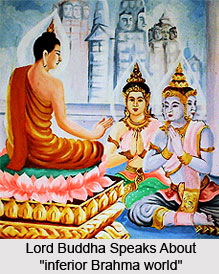 Brahma Nirvana is to merge with the Brahma. It means Moksha or emancipation. One has to give up all sensual desires, tread on the path of virtue, lead a pure life and should always be vigilant. It is only then an individual reaches his goal of permanent peace and liberation. The phrase "Brahma Nirvana" is peculiar to the Gita. The essence of the concept is that the Brahma alone is the absolute reality. The expression Brahma Nirvana implies that human life finds its fulfilment in merging with the Brahma. In the process the illusion that "I am the body" gets destroyed. All undertakings, personal lives, social service, acquisition of knowledge, meditation of individuals have the supreme purpose of Brahma Nirvana in view. This particular profound meaning has also been conveyed by the Bhagavad Gita.
Brahma Nirvana is to merge with the Brahma. It means Moksha or emancipation. One has to give up all sensual desires, tread on the path of virtue, lead a pure life and should always be vigilant. It is only then an individual reaches his goal of permanent peace and liberation. The phrase "Brahma Nirvana" is peculiar to the Gita. The essence of the concept is that the Brahma alone is the absolute reality. The expression Brahma Nirvana implies that human life finds its fulfilment in merging with the Brahma. In the process the illusion that "I am the body" gets destroyed. All undertakings, personal lives, social service, acquisition of knowledge, meditation of individuals have the supreme purpose of Brahma Nirvana in view. This particular profound meaning has also been conveyed by the Bhagavad Gita.
Brahma is immensity; it is the all-comprehensive. The purpose of human life is to transcend the narrow cohesion of the body and to merge in the infinite that is the Brahma. One form of life is larger than another. A third is larger still. There is also diversity among the manifested forms of life. But creatures, in comparison with Brahma are most insignificant. They are finite, confined within limits. The subject of man`s speculation, the object of all his reflection, is to discover means of transcending his limitations, to set himself free to be merged in infinity. This is what is known as Brahma Nirvana.
When a man has achieved Brahma Nirvana the walls of flesh drop away. According to the concept of Brahma Nirvana the body is useful and even essential up to a point. When a man`s perception widens the body becomes less and less significant. The body belongs to the primary stage in the practice of this all-pervasiveness. In the later stages the body becomes a hindrance. Knowledge or Jnana, contemplation or Dhyana or Upasana and work or Karma Yoga are all begun in the body and find it useful at the start. But later as these disciplines bring insight, the infinite is envisioned more and more clearly and all things are seen to be contained in and permeated by the Atman. The body thus serves its purpose.
In the state of Brahma Nirvana an individual discards the feelings of lust, anger, and ego and seeks happiness in being one with the Ultimate Reality. In him appears a consciousness which is in fact a transcendental consciousness. It is the extinction of the false self and the culmination towards a higher self.
As long as human beings are exclusively identified with their bodies, they shut off from the fullest communion with all creation. The body in such a case is the barrier. The body prevents human from entering into the hearts of all or the universal heart. The body is useful to individuals as long as it serves as an instrument to understand the hearts of others. Individual existence gives one the opportunity to understand the sorrows and pleasures of others through our own experience. If the hear is capable of empathy and feels the sorrow of another as though it is its own, the body is an asset to understanding but when one has glimpsed the essence of the heart of all beings, when one has experienced communion with the totality of manifested life, an exclusive identification with one body and the restricted field of its senses, mind and judgment become a hindrance to understanding. To transcend these limits, to scale these barriers, to right perception is the final object of the heart. To seek communion with and assimilation into all manifested life, to merge into the infinite, to lose one`s identity in the Brahma; this state is known as Brahma Nirvana.




















